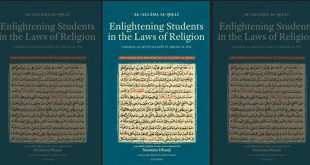2- Shi’as’ Sources of Deduction
Within the Twelver Shi’a ideology, there are four sources for deriving legal principles:
1- The Qur‘an: The Qur‘an, in its present form and outward sense is a proof (hujjah). It is the essence of Shi‘a jurisprudence.
2- Sunnah (normative custom): it means the Prophet or Imam’s sayings, deeds, and Taqrīr (his tacit approval, and silence on an act performed in front of him). Sunnah regards as a proof, while is narrated by reliable and authentic narrators. Narrator’s religion is not important. Concerning being reliable and putting into practice, a tradition narrated by a truthful non-Shi’a, is as same as a tradition narrated by a truthful Shi’a.
3- Consensus (ijmā‘): it means that, there is a unanimous agreement of Shi’a scholars on an issue. It is not considered as a proof individually, but in some conditions, mentioned in jurisprudential principles’ books; it is a means of proving Sunnah.
4- Reason: the certain judgment of human pure intelligence is the reason which is considered as a source of Shi‘a jurisprudence, like its judgment about the goodness of justice and the foulness of injustice. There is a rule among Islamic teachings named mulāzimah, which means whatever judgment is made by reason is the same as that made by religion (shar‘). Based upon this rule, some religious precept are elicited from rational judgments, like: correlation between having an obligation to do something and its preliminaries, correlation between an order to do something and forbidding its opposite, impossibility of combining command and prohibition in a single case from a single standpoint. (All these are the matters of jurisprudential principles, and the sources of religious precepts.).
Reason, (which means here, rational demonstration and logical analysis) is a base and means of thinking in Shi‘a jurisprudence. Some recent Shi‘a scholars believe that reason is a source of Shi‘a jurisprudence in potency, not in actuality. This means, although, according to jurisprudential principles, reason is recognized as an independent source of religious precepts, but there is no any case in practice. All the religious precepts that could be elicited from human pure intelligence, are presented by transmitted religious sources: The Qur‘an and Sunnah.
Point: qiyās (deductive analogy), for lack of certainty, is not a jurisprudential source from the viewpoint of Shi‘a jurisprudential principles. Qiyās means: setting up a judgment on an issue because of it is probable similarity to another one. Qiyās, by this definition, is like an analogy in logic, which is not considered as a proof in the logical and philosophical arguments. However, a logical syllogism, which is discovering the real cause, is authentic in logical arguments.
3- The most Important Jurisprudential Schools and Centers
The most important jurisprudential schools and centers, in chronological order, are as follows:
– The school of illuminated Medina: from beginning until mid-second century A.H. (the time of Imam Sādiq),
– The school of Kūfah: from mid-second century A.H until the first quarter of 4 A.H. (greater occultation),
– The school of Qum and Ray: from the first quarter of 4 A.H. until the first middle of 5 A.H. (the time of Sayyid Murtaḍā and Sheikh Tūsī),
– The school of Baghdad: from the first middle of 5 A.H., until the capture of Baghdad by Halākūkhān,
– The school of Najaf al-Ashraf (beginning the first period),
– The school of Hellah: after dissolution of science in Baghdad, it flowered in Hellah, which endured until the time of Shahīd al-Awwal (the first martyr) and Shahīd al-Thānī (the second martyr),
– The school of Shām (Halab & Jabal ‘āmil),
– The school of Isfahan,
– The school of Bahrain,
– The school of Karbala,
– The school of Najaf al-Ashraf (beginning the second period),
– The school of Qum (beginning the second period=present time).
 Ijtihad Network Being Wise and Faithful Muslim in the Contemporary World
Ijtihad Network Being Wise and Faithful Muslim in the Contemporary World
